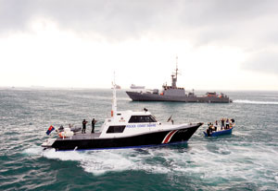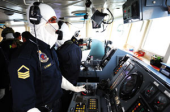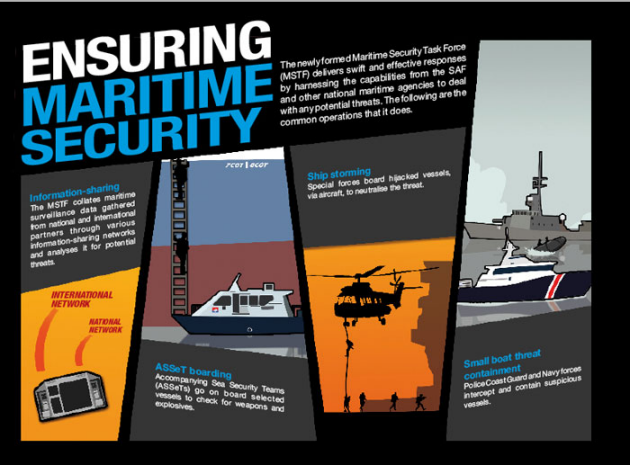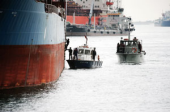OPS & TRAINING
GUARDIANS OF THE SEA
26 Mar 2009

The recent increase in reports on piracy, sea robberies and even terror infiltration via sea routes underscores the fact that seaward defence is just as important as defending our air and land borders.
To counter the multi-faceted nature of maritime threats, a Maritime Security Task Force (MSTF) has been set up by the Singapore Armed Forces (SAF) as part of its ongoing transformation to become the 3rd Generation fighting force. PIONEER looks at how the MSTF positions itself to safeguard our waters, and brings you snippets of the task force in action.
A private fishing trawler and inflatable dinghies were all it took for 10 terrorist gunmen to gain entry into Mumbai, where they later went on a killing spree that left almost 200 dead in November 2008.
An important lesson to be learnt from the Mumbai attack is that with Singapore's geographical similarities with Mumbai, the waterways that surround us can potentially be a passageway for terror too.
As paralysing as terror may be, it is possible to limit its reign, and in the case of Mumbai, it could even have been prevented. But it will take the continual commitment and sustained cooperation from nations to put a leash on terror, in the hope of eventually eliminating it.
More, greater capabilities
The strategic location of Singapore at the meeting point of the Indian Ocean and South China Sea has made Singapore one of the world s busiest ports, with more than 1,000 vessels plying the Singapore Strait daily. While that may be an economic boon for the Republic, it can also translate into its sea lines being lucrative hunting grounds for sea robbers, pirates and terrorists.
To combat the wide spectrum of such threats, the Republic of Singapore Navy's (RSN's) Coastal Command (COSCOM) was recently restructured to form the MSTF. Inaugurated on 19 Jan, the MSTF complements the Island Defence Headquarters and Air Defence Operations Command which are part of Singapore's comprehensive security measures.
Compared to its predecessor COSCOM, a Navy-level formation which could only muster assets organic to the RSN, the MSTF, as an SAF-level task force, has a wider range of capabilities.
The MSTF reports directly to the Chief of Defence Force, and is able to mobilise assets from all three Services of the SAF, namely the RSN, the Army and the Republic of Singapore Air Force (RSAF). This allows it to "mix and match the range of capabilities required, and integrate them to form useful and more precise responses to the whole range of maritime security threats", said Chief of Navy Rear-Admiral (RADM) Chew Men Leong.
Working closely together
The SAF is not alone in its battle against maritime threats faced by Singapore. Key national maritime agencies have individually been pro-actively involved in protecting the waters that surround the island state. The MSTF amalgamates the efforts and assets of these individual agencies to form a more potent force.
"The MSTF will look at maritime security challenges holistically and foster tighter coordination among the ground units," said Commander MSTF Colonel (COL) Tan Wee Beng, explaining the inter-agency approach that the MSTF has adopted in dealing with security threats.
With the co-location of representatives from key national maritime agencies at the MSTF, such as the Police Coast Guard (PCG), the Maritime Port Authority, the Immigration and Checkpoints Authority (ICA) and the Singapore Customs, Singapore's ability to rally a quick and effective national response to potential maritime security threats is significantly enhanced.
Common operating picture
Each of the maritime agencies mentioned functions like a nerve ending within the MSTF, relaying pieces of information it receives to the MSTF, which is very much like a nerve centre.
Using surveillance and intelligence information received from the various agencies, the MSTF performs sense-making of the information and pieces all that into a common operating picture - one that paints a more coherent picture of the overall situation, highlights anomalies and warns of potential threats to maritime security.
With this common operating picture, the MSTF is then able to marshal the necessary resources and direct any required action in response to the threats.
Transnational collaboration
In order to put together a comprehensive maritime picture, the MSTF needs to use the resources of international partners as leverage.
Information-sharing with international maritime agencies is therefore critical to the MSTF's awareness of the regional maritime situation.
Elaborating on the transnational role of the MSTF, RADM Chew said: "The MSTF will also be the one-stop agency that will drive our transnational collaboration...it will be the node which will continue to essentially maintain and nurture all our key linkages to like-minded partners".
To emphasise the importance and efficacy of transnational collaboration, RADM Chew cited the example of the Malacca Straits Patrols (MSP). Since 2004, Malaysia, Indonesia and Singapore have committed themselves to ensuring maritime security in the Malacca Strait, with Thailand joining them in 2008.
The MSTF has already been fronting Singapore's participation in the MSP since its inauguration, and has even introduced an information-sharing system that is currently being used by all members of the MSP.
This system allows information to be shared on a real-time basis, such that all countries can be alerted the moment anomalies are detected by one party, enabling them to coordinate efforts to handle the threats.
Such information-sharing initiatives across borders have produced encouraging results - instances of piracy in the Malacca Strait have steadily declined from a high of 38 in 2004 to a low of four in 2008 according to MSP records.
Integrated structure
Enabling the MSTF to effectively combat maritime security threats and challenges through inter-agency cooperation and transnational collaboration is its structure which comprises three groups.
The Comprehensive Maritime Awareness (CMA) Group functions as the brains of the MSTF, where information from a variety of sources is received, stored and analysed. This collation of information is made possible through the CMA group working closely with national agencies, international partners, and members of the shipping community such as ship owners, ship charterers, agents and port operators.
With round-the-clock surveillance, an information-sharing network with partners and thorough research, the CMA group builds a comprehensive maritime situational picture, enabling early detection and identification of threats.
The second arm of the MSTF is the Operations Group. Composed of planners from all three Services of the SAF, this group utilises the comprehensive information from the
CMA group to plan and execute operations. With the conduct of daily patrols, boarding and escort operations within the Singapore Strait, a high level of maritime security and protection of our key installations is maintained.
Ensuring seamless coordination in the execution of operations at the national level is the Inter-Agency Coordination Group, which incorporates representatives from the participating national maritime agencies.
Put to the test
With an integrated structure to ensure that the MSTF operates like clockwork in place, all that was left was to set the gears in motion.
This year, from 9 to 23 Feb, the fledgling task force validated its capabilities and operational readiness with its debut in Exercise Apex. First conceived in 1983, this annual exercise gathers the same maritime agencies to test, validate and review operational responses to a wide range of contingency scenarios out at sea.
The exercise, which saw the participation of more than 1,800 personnel from the SAF and other maritime agencies, also provided opportunities for planners from these agencies to "come together to visit new challenges in maritime security", said Superintendent Wong Hong Meng, Deputy Commander, Operations and Intelligence, ICA Coastal Command.
Deputy Prime Minister and Coordinating Minister for National Security Professor S Jayakumar and Minister for Defence Teo Chee Hean witnessed some of the scenarios on the last day of the exercise.
In one of the scenarios, a large merchant vessel was seen sailing through the waters. Next, a small vessel carrying a handful of men was launched from the merchant vessel, appearing just like any other fishing boat, until it started charging towards one of Singapore's key installations - Jurong Island.
Their intentions were unclear, but their unusual approach did not go unnoticed. In addition, the men on board the vessel did not respond when a Long Range Acoustic Device (LRAD) was used in an attempt to establish contact and determine their intentions.
Just seconds before armed men on the small boat achieved their aim of infiltrating Jurong Island, a PCG vessel charging at break-neck speed intercepted the small boat. An anti-submarine patrol vessel, one of the many assets under MSTF's command, also closed in on the small boat, thereby extinguishing the threat.
In another scenario, an Accompanying Sea Security Team (ASSeT) boarded a merchant vessel which was to call at Singapore. The team, comprising MSTF personnel from the Navy and the PCG, checked for weapons and explosives on board the vessel. During this process, ICA officers could also be activated to conduct checks on the crew members.
Ready and capable
The showcase of its capabilities during Exercise Apex underscored the ability of the MSTF to coordinate a national response to maritime threats within a short lead time.
Commenting on how the exercise also hones the skills of national maritime agencies, Deputy Superintendent of Police Alan Tan, Head Operations and Security, Police Coast Guard, said that Exercise Apex "remains a good platform to practise coordination with the other maritime agencies and to validate new operational concepts to deal with emerging threats".
The exercise also highlighted a very real threat caused by small boats, usually thought to be harmless, but may possess the intention to attack Singapore, as with the Mumbai incident.
With about 100 of such small vessels passing through the Singapore Strait daily, differentiating those that are potential threats from those that are not is a challenging task. But the years of experience in surveillance and information building that the people in the MSTF have contributes to the task force's accuracy in tracking down small boat threats.
"Usually, small boats carry around two fishermen. So if we see five men on board a small vessel, it raises suspicion, and from there, we trigger a response to identify if it's a threat," said the task force deputy commander, COL Chua Meng Seng.
The MSTF will also use the information-sharing network it has with its international and national partners as leverage to be more aware of threats entering Singapore's waters. This gives the MSTF more lead time to coordinate actions against potential pirates or terrorists before they enter territorial waters.
Keeping a constant watch
Even with such a formidable display of the MSTF's capabilities and operational readiness, the task force looks set to push ahead in sharpening its skill sets, and developing better capabilities to identify and plug any operational gaps in the maritime security system.
Affirming this, RADM Chew said: "We will not be complacent, we will be absolutely vigilant", as he explained the importance of not letting down our guard against risks from maritime threats.
The MSTF, which will be housed at the Changi Command and Control Centre come 2010, is conducting its operations from Tuas Naval Base in the meantime.
One of the biggest concerns the MSTF faces is the possibility of there being a connection among pirates, sea robbers and terrorists. As such, the MSTF has to build a much stronger system to keep constant watch over Singapore's waters.
"We need to be one step ahead of the evolving maritime security threats, and we want to make sure that we can close all the potential operational gaps, to make sure our maritime security system is much more robust," RADM Chew concluded.
ALSO READ IN OPS & TRAINING

Exercise Wallaby 2025: To see better, shoot faster
31 Oct 2025
The SAF focuses on complex strike missions and multi-domain integration in Exercise Wallaby 2025, the 35th edition of its largest unilateral overseas exercise.

Ex Wallaby 25 – Greater Integration and Complexity
25 Oct 2025
The 35th edition of the SAF’s largest unilateral overseas exercise is an opportunity for expanded scale and deeper integration towards an effective, networked fighting force.

Ex Forging Sabre ramps up use of unmanned assets in integrated strike operations
12 Sep 2025
In this 10th edition of Exercise Forging Sabre, the SAF sharpened its cutting edge for the dynamic modern battlefield, with expanded integration between manned and unmanned platforms.










